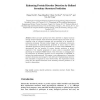188 search results - page 6 / 38 » Improving protein secondary structure prediction using a sim... |
BMCBI
2008
13 years 7 months ago
2008
Background: Protein domains present some of the most useful information that can be used to understand protein structure and functions. Recent research on protein domain boundary ...
BIRD
2007
Springer
14 years 1 months ago
2007
Springer
More and more proteins have been observed to display functions through intrinsic disorder. Such structurally flexible regions are shown to play important roles in biological proces...
BMCBI
2006
13 years 7 months ago
2006
Background: We describe Distill, a suite of servers for the prediction of protein structural features: secondary structure; relative solvent accessibility; contact density; backbo...
EUROGP
2004
Springer
14 years 26 days ago
2004
Springer
Predicting the three-dimensional structure of proteins is a hard problem, so many have opted instead to predict the secondary structural state (usually helix, strand or coil) of e...
BIBM
2010
IEEE
13 years 5 months ago
2010
IEEE
ATP is a ubiquitous nucleotide that provides energy for cellular activities, catalyzes chemical reactions, and is involved in cellular signaling. The knowledge of the ATPprotein in...

